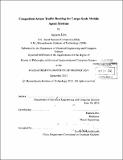| dc.contributor.advisor | Daniela Rus. | en_US |
| dc.contributor.author | Lim, Sejoon | en_US |
| dc.contributor.other | Massachusetts Institute of Technology. Department of Electrical Engineering and Computer Science. | en_US |
| dc.date.accessioned | 2013-04-12T19:25:13Z | |
| dc.date.available | 2013-04-12T19:25:13Z | |
| dc.date.copyright | 2012 | en_US |
| dc.date.issued | 2012 | en_US |
| dc.identifier.uri | http://hdl.handle.net/1721.1/78452 | |
| dc.description | Thesis (Ph. D.)--Massachusetts Institute of Technology, Dept. of Electrical Engineering and Computer Science, 2012. | en_US |
| dc.description | Cataloged from PDF version of thesis. | en_US |
| dc.description | Includes bibliographical references (p. 191-201). | en_US |
| dc.description.abstract | Traffic congestion is a serious world-wide problem. Drivers have little knowledge of historical and real-time traffic congestion for the paths they take and often tend to drive suboptimal routes. Congestion phenomena are sure to be influenced by the coming of autonomous cars. This thesis presents route planning algorithms and a system for either autonomous or human-driven cars in road networks dealing with travel time uncertainty and congestion. First, a stochastic route planning algorithm is presented that finds the best path for a group of multiple agents. Our algorithm provides mobile agents with optimized routes to achieve time-critical goals. Optimal selections of agent and visit locations are determined to guarantee the highest probability of task achievement while dealing with uncertainty of travel time. Furthermore, we present an efficient approximation algorithm for stochastic route planning based on pre-computed data for stochastic networks. Second, we develop a distributed congestion-aware multi-agent path planning algorithm that achieves the social optimum, minimizing aggregate travel time of all the agents in the system. As the number of agents grows, congestion created by agents' path choices should be considered. Using a data-driven congestion model that describes the travel time as a function of the number of agents on a road segment, we develop a practical method for determining the optimal paths for all the agents in the system to achieve the social optimum. Our algorithm uses localized information and computes the paths in a distributed manner. We implement the algorithm in multi-core computers and demonstrate that the algorithm has a good scalability. Third, a path planning system using traffic sensor data is then implemented. We predict the traffic speed and flow for each location from a large set of sensor data collected from roving taxis and inductive loop detectors. Our system uses a data-driven traffic model that captures important traffic patterns and conditions using the two sources of data. We evaluate the system using a rich set of GPS traces from 16,000 taxis in Singapore and show that the city-scale congestion can be mitigated by planning drivers' routes, while incorporating the congestion effects generated by their route choices. | en_US |
| dc.description.statementofresponsibility | by Sejoon Lim. | en_US |
| dc.format.extent | 201 p. | en_US |
| dc.language.iso | eng | en_US |
| dc.publisher | Massachusetts Institute of Technology | en_US |
| dc.rights | M.I.T. theses are protected by
copyright. They may be viewed from this source for any purpose, but
reproduction or distribution in any format is prohibited without written
permission. See provided URL for inquiries about permission. | en_US |
| dc.rights.uri | http://dspace.mit.edu/handle/1721.1/7582 | en_US |
| dc.subject | Electrical Engineering and Computer Science. | en_US |
| dc.title | Congestion-aware traffic routing for large-scale mobile agent systems | en_US |
| dc.type | Thesis | en_US |
| dc.description.degree | Ph.D. | en_US |
| dc.contributor.department | Massachusetts Institute of Technology. Department of Electrical Engineering and Computer Science | |
| dc.identifier.oclc | 832442292 | en_US |
